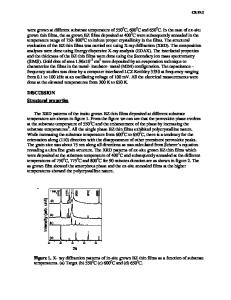Growth and Characterization of Germanium-based type I Clathrate Thin Films Deposited by Pulsed Laser Ablation
- PDF / 1,673,527 Bytes
- 6 Pages / 612 x 792 pts (letter) Page_size
- 65 Downloads / 388 Views
0886-F10-03.1
Growth and Characterization of Germanium-based type I Clathrate Thin Films Deposited by Pulsed Laser Ablation S. Witanachchi, R. Hyde, H. S. Nagaraja, M. Beekman, G. S. Nolas, and P. Mukherjee Department of Physics, University of South Florida, Tampa, FL 33620 ABSTRACT Thin films of clathrate material have been grown using the laser ablation technique on a variety of substrates. Films deposited on silicon substrates exhibited a significant deficiency of Ga and Ge while the stoichiometry was preserved in films deposited on quartz, sapphire, and glass substrates. Ablation characteristics of the clathrate target for laser radiation at three different wavelengths in the UV, visible and IR were studied. The UV and IR laser wavelengths produce low ablation thresholds and high growth rates. Crystalline films were obtained above a growth temperature of 400oC. Conductivity measurements on the films at low current injection ( 2 J/cm2) . For all three laser wavelengths that were used in the study, stoichiometric evaporation was observed. Films deposited on most of the substrates were stoichiometric, except for silicon where low sticking coefficient led to deficiency in Ga and Ge. Films transformed from amorphous to crystalline structure above a growth temperature of 400oC. Growth temperatures above 600oC caused partial decomposition leading to the precipitation of Ge. At low injection currents films showed semiconductor behavior. The semiconductor-to-metallic transition observed as a function of decreasing temperature at high injection currents is currently being explored. Possible mechanisms for this behavior include grain-boundary effects, temperature dependent bandgap changes as well as more trivial enhanced local joule heating at high currents and high resistivities at low temperature.
ACKNOWLEDGEMENTS
This project is partially supported by the US Department of Energy, under Grant No. DEFG02-04ER46145 and National Science Foundation, under Grant No. DMI-0217939. MB gratefully acknowledges support from the University of South Florida Presidential Doctoral Fellowship.
REFERENCES Semiconductors and Semimetals, V. 69, 70, & 71, ed. T.M. Tritt, (Academic Press, 2001). G.A. Slack, “New Materials and Performance Limits for Thermoelctric Cooling,” CRC Handbook of Thermoelectrics, ed. D.M. Rowe (CRC Press, 1995), pp. 407-440. 3. G.S. Nolas, D.T. Morelli, and T.M. Tritt, Annu. Rev. Mater. Sci. 29, 89 (1999). 4. C. Uher, “Skutterudites: Prospective Novel Thermoelectrics,” Semiconductors and Semimetals, V. 69, ed. T.M. Tritt (Academic Press, 2001), pp. 139-253. 5. G.A. Slack, Mater. Res. Soc. Symp. Proc. 478, 47 (1997). 6. G.S. Nolas, J.L. Cohn, G.A. Slack, and S.B. Schujman, Appl. Phys. Lett. 73, 178 (1998). 7. C. Cros, M. Pouchard, and P. Hagenmuller, J. Solid State Chem. 2, 570 (1970). 8. J.L Cohn, G.S. Nolas, V. Fessatidis, T.H. Metcalf, and G.A. Slack, Phys. Rev. Lett. 82, 779 (1999). 9. S. Witanachchi, K. Ahmed, P. Sakthivel and P. Mukherjee, Applied Physics Lettters, 66, 1469-1471 (1995). 10. P. Mukherjee, J.B
Data Loading...










